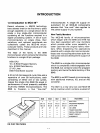
INTRODUCTION
three levels
of
subroutines may
be
ac-
commodated.
Instruction Register and Decoder
Every computer has a Word Length that
is
characteristic
of
that machine. A computer's
word
length
is
usually determined by the size
of
its internal storage elements and intercon-
necting paths (referred
to
as
Buses); for
example, a computer whose registers and
buses can store and transfer 8-bits
of
information has a characteristic word length
of
8-bits and
is
referreq to
as
an
8-bit parallel
processor. An 8-bit parallel processor gener-
ally finds it most efficient to deal with 8-bit
binary
fields, and the memory associated
with
such a processor
is
therefore organized
to store 8-bits in each
addressable memory
location. Data and instructions are stored in
memory
as
8-bit binary numbers,
or
as
numbers that are integral multiples of 8-bits:
16-bits, 24-bits, and
so
on. This characteristic
8-bit field
is
often referred to
as
a Byte. If
however, efficient handling of 4
or
even 1-bit
data
is
necessary special processor instruc-
tions can provide this
capability.
Each operation that the processor can
perform
is
identified by a unique byte of data
known
as
an
Instruction Code
or
Operation
Code. An 8-bit word used
as
an
instruction
code can distinguish between
256
alternative
actions, more
than'
adequate for most
processors.
The processor fetches
an
instruction in two
distinct operations. First, the processor
transmits the address
in
its Program Counter
to the program memory. Then the program
memory returns the addressed byte to the
processor. The CPU stores this instruction
byte in a register known
as
the Instruction
Register, and uses it to direct activities during
the remainder of the instruction execution.
The 8-bits stored in the instruction register
can
be
decoded and used to selectively
activate one
of
a number
of
output lines. Each
line represents a set of activities associated
with execution
of
a particular instruction
code. The
enabled line can be combined with
selected timing pulses, to develop 'el'ectrical
1·7
signals that can then be used to initiate
specific actions. This
translation of code into
action
is
performed by the Instruction
Decoder and by the associated control
circuitry.
An 8-bit instruction code
is
often sufficient to
specify a
particular processing action. There
are times, however, when execution of the
instruction requires more information than
8-
bits can convey.
One example of this
is
when the instruction
references a memory
location. The basic
instruction code identifies the operation to be
performed, but cannot specify the object
address
as
well.
In
a case like this, a two byte
instruction must
be
used. Successive instruc-
tion bytes are stored
in
sequentially adjacent
memory
locations, and the processor per-
forms two fetches
in
succession
to
obtain the
full instruction. The first byte retrieved from
memory
is
placed in the prbcessor's instruc-
tion register, and
subseq!Jent byte
is
placed
in temporary storage;
t~e
processor then
proceeds with the
executio
l1
phase.
Address Register(s)
A CPU may use a register to
hold the address
of
a memory location that
is
to be accessed
for data.
If the address register
is
Program-
mable,
(Le.,
if there are instructions that allow
the programmer to alter the contents
of
the
register) the program can
"build"
an
address
in the address register prior to executing a
Memory Reference instruction
(Le.,
an
instruction that reads data from memory,
writes data to memory
or
operates on data
stored in memory).
Arithmetic/Logic Unit (ALU)
All processors contain
an
arithmetic/logic
unit, which
is
often referred to simply
as
the
ALU. The ALU,
as
its name implies,
is
that
portion
of
the CPU hardware which performs
the arithmetic and
logical operations on the
binary data.
The ALU must contain
an
Adder which
is
capable
of
combining the contents
of
two
registers
in
accordance with the logic
of
binary arithmetic. This provision permits the


















